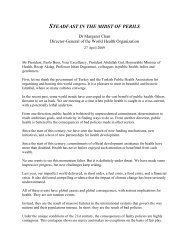The Evolution of HTA in Emerging Markets Health-Care ... - TREE
The Evolution of HTA in Emerging Markets Health-Care ... - TREE
The Evolution of HTA in Emerging Markets Health-Care ... - TREE
You also want an ePaper? Increase the reach of your titles
YUMPU automatically turns print PDFs into web optimized ePapers that Google loves.
OHE Consult<strong>in</strong>g Report for PhRMA<br />
5 January 2011<br />
8.2 Summary <strong>of</strong> f<strong>in</strong>d<strong>in</strong>gs on the three countries<br />
We set out our detailed f<strong>in</strong>d<strong>in</strong>gs on the health care systems and use <strong>of</strong> <strong>HTA</strong> <strong>in</strong> these countries <strong>in</strong><br />
Appendices to this report. In this section, we describe some key attributes <strong>of</strong> the three systems <strong>in</strong><br />
the context <strong>of</strong> our discussion <strong>of</strong> the evolution <strong>of</strong> health care systems and <strong>of</strong> <strong>HTA</strong>.<br />
8.2.1 Brazil<br />
We have noted that health care f<strong>in</strong>anc<strong>in</strong>g evolves over time, mov<strong>in</strong>g from predom<strong>in</strong>antly out-‐<strong>of</strong>-pocket<br />
fund<strong>in</strong>g to elements <strong>of</strong> <strong>in</strong>surance through to more-‐or-‐less universal coverage vary<strong>in</strong>g from<br />
country to country. Typically employer-‐based schemes for urban workers beg<strong>in</strong> before schemes<br />
cover<strong>in</strong>g rural workers who are usually self-‐employed. In Brazil this was the case with the 1923 Eloi<br />
Chaves Law provid<strong>in</strong>g for employer-‐based <strong>in</strong>surance. <strong>The</strong> extent to which the various third party<br />
payer <strong>in</strong>surance schemes are comb<strong>in</strong>ed over time varies from country to country. Some move to a<br />
s<strong>in</strong>gle payer system, others keep multiple <strong>in</strong>surers and, <strong>in</strong> some cases, these <strong>in</strong>surers compete for<br />
enrolees. Brazil’s current system is the United <strong>Health</strong> System (SUS) <strong>in</strong>troduced <strong>in</strong> 1988. It is a s<strong>in</strong>gle<br />
payer universal coverage scheme with significant regional and local variation. <strong>The</strong>re is, however,<br />
separate supplementary Private Insurance regulated by the National Agency for Supplementary<br />
<strong>Health</strong> (ANS). Regulated private <strong>in</strong>surance is the ma<strong>in</strong> provider <strong>of</strong> health care for many citizens (25%<br />
<strong>of</strong> the population) because <strong>of</strong> the limited f<strong>in</strong>anc<strong>in</strong>g <strong>of</strong> the SUS. <strong>The</strong> ANS fixes maximum premiums<br />
and procedures to be covered. <strong>The</strong>se private plans need not cover oral drugs or home treatment.<br />
<strong>The</strong> element <strong>of</strong> any develop<strong>in</strong>g health care system that arguably evolves the most slowly is<br />
purchas<strong>in</strong>g. Initially, <strong>in</strong>surance coverage typically accepts fee-‐for-‐service with the role <strong>of</strong> the third<br />
party payer be<strong>in</strong>g to passively pay the bills <strong>of</strong> the provider rather than actively decide what it is go<strong>in</strong>g<br />
to cover, who should provide it, and how they are to be paid. Over time, more sophisticated<br />
mechanisms for <strong>in</strong>centivis<strong>in</strong>g and reward<strong>in</strong>g providers tend to be used, notably capitation payments<br />
and ‘prospective’ or case-‐mix adjusted payments to hospitals. SUS uses diagnosis-‐related groups<br />
(DRGs). HMOs <strong>in</strong> Brazil are seek<strong>in</strong>g to negotiate DRG-‐type packages.<br />
Brazil has three programmes for <strong>in</strong>surance coverage for pharmaceuticals. Covered drugs <strong>in</strong> all three<br />
programs are <strong>of</strong>fered free to patients prescribed them, though, like <strong>in</strong> most countries, actual access<br />
and use vary geographically and by socioeconomic status. <strong>The</strong> National Commission for Technology<br />
Incorporation <strong>of</strong> the M<strong>in</strong>istry <strong>of</strong> <strong>Health</strong> (CITEC) reviews drugs on the Component <strong>of</strong> Specialised<br />
Pharmaceutical Assistance, which have a high budget impact.<br />
Issues around the use <strong>of</strong> <strong>HTA</strong> <strong>in</strong> Brazil<br />
Despite the creation <strong>of</strong> an <strong>HTA</strong> body (CITEC) focuss<strong>in</strong>g on “micro” <strong>HTA</strong> and hundreds <strong>of</strong> submissions,<br />
the delays <strong>in</strong> reviews and lack <strong>of</strong> transparency about the decision-‐mak<strong>in</strong>g process have resulted <strong>in</strong><br />
great uncerta<strong>in</strong>ty about its ultimate impact. <strong>The</strong> follow<strong>in</strong>g issues and trends arise:<br />
<br />
<strong>HTA</strong> can be seen as a “black box” with little thought given to appropriate processes to<br />
ensure the <strong>in</strong>volvement <strong>of</strong> stakeholders: clear parameters for decisions have not been made<br />
transparent.<br />
52








